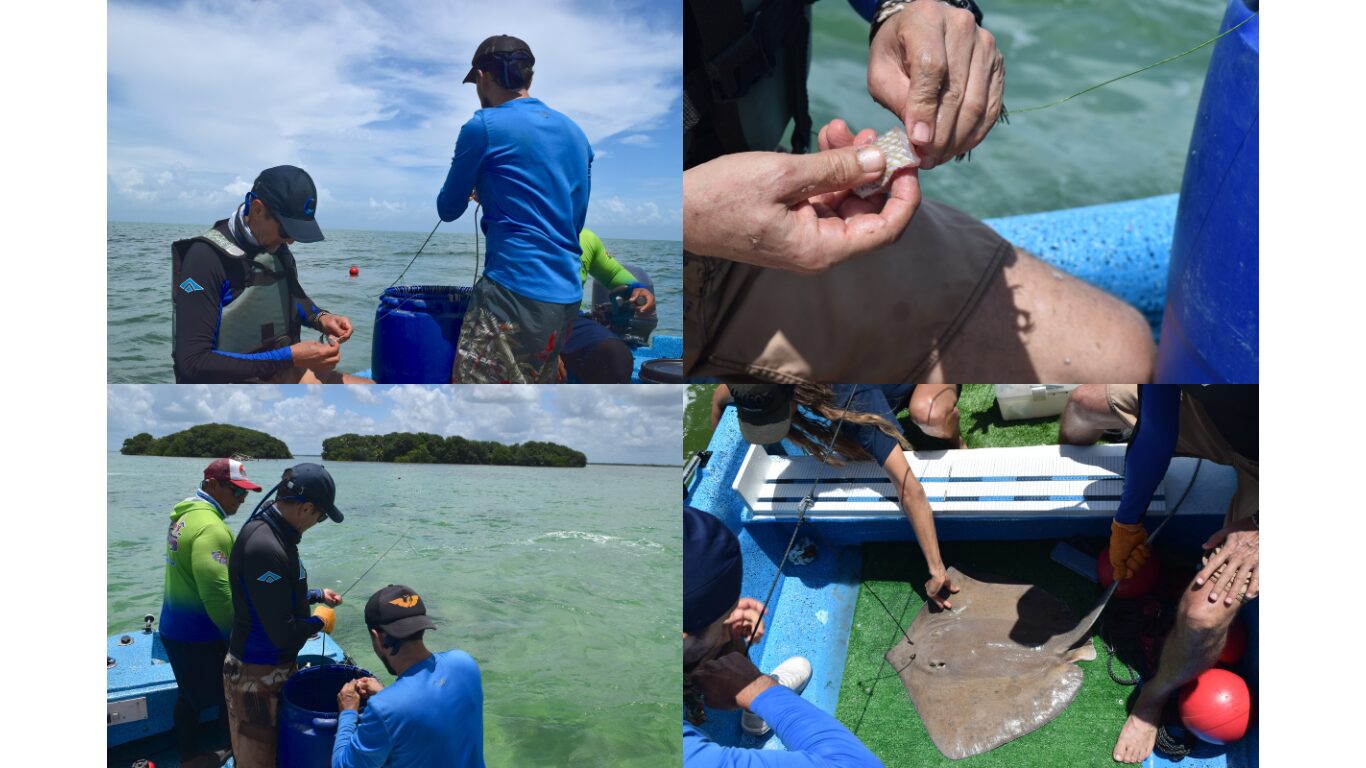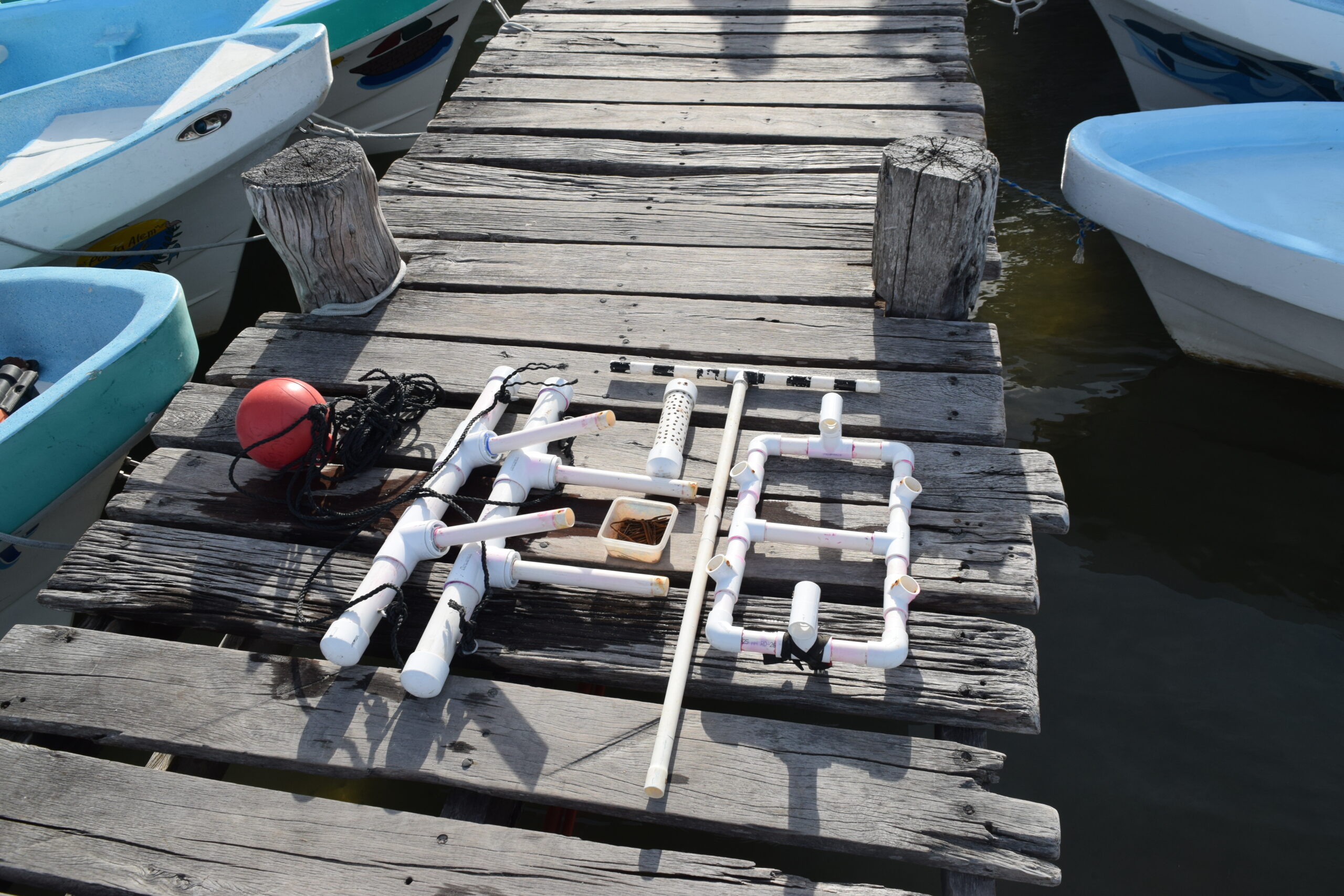Making sure our DIY equipment actually works in the field; a critical part everyone should take into account
Time passed so very slowly during the months we had to wait between completing the construction of our DIY longlines and BRUVS and finally getting the required permit from CONAPESCA (the Mexican commission for fisheries) that would allow us to start our ambitious sampling field-campaigns. Unfortunately, bureaucracy is sometimes very inefficient in Mexico, and it took CONAPESCA a whole 9 months to issue our permit, something that should have taken them only 3 months.
Fortunately, we used our time efficiently and took advantage of this situation to test our longlines and BRUVS in the meantime. Our goal was to make sure they performed well and didn’t break apart due to possible mistakes in the design. Thus, we spend a few days testing them in the field in locations close to our home base, Chetumal.

Baiting the hooks of our first 50-hook longline (top left); carefully setting the longline a few miles off the city of Chetumal (top right); a longnose stingray Hypanus guttatus is our first catch (bottom left); admiring our catch before releasing it alive (bottom right). Photos © Ramón Bonfil
First, we used one of one longlines and one BRUVS in Chetumal Bay for a test just a few miles in front of the city, and although water clarity was not particularly good during that season, our longline stood the trial and we even managed to catch a longnose stingray Hypanus guttatus, which was obviously released alive immediately. Our BRUVS took a 1-hour video, but due to the turbidity in the bay that day, we did not manage to see any sharks or rays.

Photos © Ramón Bonfil
A month later, we tested our longline once more in a farther-away part of Chetumal Bay, where local fishers regularly set fishing gear, and we again caught another longnose stingray. This made us feel confident that we knew how to build our own longlines, we got familiar on how to use them, and confirmed that they were actually able to catch live elasmobranchs. Chetumal Bay is known as a habitat with very scarce fish fauna due to environmental and oceanographic conditions, so our low catches were not particularly worrying. However, the important point was that my graduate students managed to get some very valuable practice and familiarity with how longlines are set, retrieved from the water and used.

Second test of our 50-hook longline, this time in a real fishing ground in Chetumal Bay; again, a longnose skate was our prize, which we promptly returned alive back to the water. Photo © Ramón Bonfil
Finally, later in the summer we went to Bacalar Lagoon to deploy our first 4 BRUVS and take photographs of them resting on the bottom of the lagoon. A major advantage of our design, is that we built them easy to assemble and disassemble relatively fast such that they do not require a lot of space for transportation in a car or truck. We didn’t try to record any video during these trials because we knew that very little or no elasmobranchs have been reported in this brackish water lagoon, but we wanted to see how they sat on the bottom and stayed in place. We were able to easily carry them on a paddle board and deploy them in the bottom at several points near the shore. All of them sat flat on the bottom and did not come apart during the lowering or recovery from the bottom: they all seemed pretty rough.

We designed our BRUVS such that they are easy to disassemble for ease of transportation. Photo © Ramón Bonfil

Assembling our first 4 BRUVS to test how they sit on the bottom and how sturdy they are (bottom left); BRUVS sitting in the bottom of Bacalar Lagoon in about 6 m depth (top right) and 3 m depth (bottom left); our first design, had the bait container perpendicular to the front edge of the BRUVS and we used a PVC frame with 5 cm black and white bars, as an attempt to get estimates of the size of organisms approaching the BRUVS (bottom right). Assembling our first 4 BRUVS to test how they sit on the bottom and how sturdy they are (bottom left); BRUVS sitting in the bottom of Bacalar Lagoon in about 6 m depth (top right) and 3 m depth (bottom left); our first design, had the bait container perpendicular to the front edge of the BRUVS and we used a PVC frame with 5 cm black and white bars, as an attempt to get estimates of the size of organisms approaching the BRUVS (bottom right). Photo © Ramón Bonfil
After all these tests, we were more confident that all the sampling gear and equipment we had built, seemed to perform properly in the water and could probably work well in the field. It was time for the ultimate test: use them to actually take samples in Bahía de la Ascensión and Laguna Yalahau…
